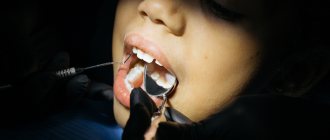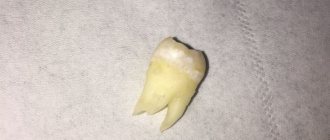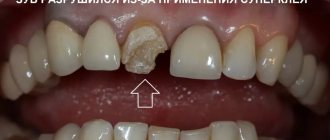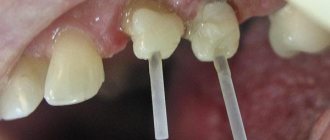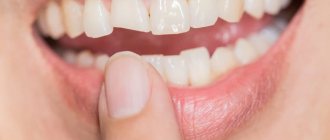Typically, the replacement of a child’s milk teeth with permanent ones occurs in two stages. At the age of 5-7 years, the primary incisors (four front teeth) change on the upper and lower jaws. Also at this age, the eruption of 6 permanent teeth (molars) occurs. They erupt without the baby teeth falling out. The second period of tooth change is the age of 10-12 years, when the canines and premolars (3, 4 and 5th teeth) change. For various reasons, a child may lose baby teeth before their natural replacement date. This may be the consequences of caries or injury.
Types of injuries to baby teeth
To choose a method to restore a broken baby tooth, you first need to determine the type of injury.
Chip on a baby tooth
A chip can occur from minor damage: a child grinds his teeth in his sleep (a common sign of helminth infection), ate solid food (crackers) or chewed a pencil, or bit a spoon unsuccessfully. When examining the oral cavity, it is discovered that a piece of the child’s baby tooth has broken off, the lower edge of the crown has become uneven and scratches the tongue. In this case, it is important to determine the extent of the damage.
If a red dot is visible on the surface of the chip, then the injury is serious and affects the pulp (nerve). And although the child will complain of acute pain when eating cold/hot food, the broken tooth can be saved.
Horizontal crack
A crack indicates an incomplete fracture of the tooth. The baby tooth has not cracked, but the crown is loose, and when the teeth are closed and biting, a sharp pain appears. The most difficult case is when the child fell, the tooth did not break off, but a crack appeared on the crown along the edge of the gum. In this case, you will likely need to strengthen the tooth with a thin veneer.
Baby tooth broken at the root
Did the kid bring a broken tooth in his hand? Unfortunately, with such an injury, it will not be possible to restore the integrity of the dentition. However, you still need to go to the dentist in order to remove the remaining fragments from the gums.
Impacted tooth fracture
With such an injury, the tooth is partially immersed in the gum. The length of the tooth is reduced compared to other crowns, but its edge is not sharp and does not scratch. Characterized by diffuse pain in the jaw. Sometimes the injury is accompanied by heavy bleeding due to the many small vessels in the gums of children.
Fractures of the alveolar process and jaw due to impacted tooth trauma are extremely rare, since the roots of baby teeth are quite short. Damage to bone tissue is indicated by severe pain spreading throughout the entire jaw on one side, the inability to open the mouth wide and a change in the bite.
Displacement of a baby tooth
With a strong blow, damage to the coronal part may be accompanied by complete or incomplete dislocation. A child’s tooth (often a front one) breaks off and takes an unusual position in the socket: it moves to the side, moves forward or backward, and turns around its axis. In this case, the tooth becomes loose, causing pain, and the child refuses to eat. The gums swell a little. In case of such an injury, the tooth is saved, but treatment may last several weeks.
Important! A chip in a baby tooth allows bacteria access to the dentin. Caries appears on the damaged crown. This often leads to its destruction within a couple of months and tooth loss.
What are the indications for the removal of baby teeth?
Common carious lesions are the most common indications for the procedure. However, this is not the only reason. One of the common indications for the removal of primary teeth is their abnormal growth, which increases the risk of malocclusion and problems during the eruption of permanent teeth.
Other indications for the removal of baby teeth are:
- the occurrence of dental diseases that can cause tissue necrosis;
- diagnosis of periodontal fistulas and abscesses, as well as other pathological changes in the gums;
- too late resorption of milk roots, which prevents the eruption of permanent teeth;
- mechanical damage that may occur as a result of a child falling.
An indication may also be the fact that a baby tooth remains in the dental arch for too long, despite the fact that the permanent one has already begun to erupt. A tooth should also be removed when it begins to move and thus makes it difficult for the child to eat and speak. In such a situation, you should not pull it out using old home methods, because this can damage the gums.
What to do if a child's baby tooth breaks off
- Is the child scared and crying? Try to calm him down. Take it in your arms, turn on your favorite cartoon or distract your baby with a game.
- If there is bleeding, apply a sterile gauze pad (do not use cotton wool - the fibers may stick to the chip).
- Try to find the tooth fragment as quickly as possible. Place it in saline solution, boiled water or wrap it in a damp cloth. This will make it easier to restore a child’s broken baby tooth.
- For pain, you can give Nurofen or paracetamol.
- If a fracture is suspected, make a circular bandage around the head, securing the lower jaw.
It is necessary to get an appointment with a dentist within the first 2-48 hours. Don't forget to take the saved tooth fragment with you.
Why do baby teeth deteriorate?
Damage to a baby tooth most often occurs due to caries in early childhood. This disease can take different forms. The wrong way to feed a baby can lead to bottle tooth decay. If the baby falls asleep with a bottle in his mouth or is given formula or sweet tea after waking up at night, then streptococcal bacteria develop in the mouth during sleep. They are the ones who contribute to the occurrence of this variant of the disease.
In older children, two and three years of age, circular caries is observed. This is the name of the early stage of caries with an acute course. It first begins to attack the front teeth, most often in the upper jaw and symmetrically on both sides, and then leads to pulp complications. A tooth with a damaged crown is not suitable for root canal treatment and must be removed. Leaving a baby tooth damaged by caries is dangerous because it is an inflammatory source in the child’s mouth.
Another very common cause of loss of baby teeth is childhood trauma. It is not uncommon for a child to lose teeth due to a fall. One of the main reasons is that the design of primary incisors is completely different from permanent incisors. They are smaller, have shorter roots, and the jaw bones are more spongy. Children of certain ages are at greater risk of injury:
- the first and second years of life are when they are just learning to walk, but the older the child, the greater the risk;
- later, at the age of four to six, other activities appear: playing with a ball, running, climbing.
So it is not difficult to lose a tooth. Often, the premature loss of baby teeth in children is not given much attention. However, the roots of an extracted baby tooth are usually not completely resorbed, and the root of a permanent tooth is still in the early stages of development. This has quite serious consequences, so the indications and contraindications for removal should not be ignored.
Possible treatment options
The method of preserving a damaged baby tooth depends on the degree of damage. Sometimes the dentist suggests taking an x-ray to diagnose damage to adjacent crowns, tooth dislocation and assess the condition of surrounding tissues. Before restoring a tooth, the dentist performs hygienic treatment of the oral cavity.
Treatment methods for a chipped baby tooth
- Enamel chipped - polishing the sharp edges of the crown.
- A baby tooth has broken off within the dentin - building it up with photocomposite material or covering the chip with a crown fragment.
- Fracture exposing the dental nerve - reconstruction using a tooth fragment.
- Mobility, displacement of teeth - applying a splint to the damaged tooth and two adjacent crowns (one on the right and on the left) under local anesthesia.
- A child has a cracked baby tooth in the root zone - sealing the damage and strengthening the crown with an onlay.
Thanks to the precise selection of the color of the composite material, the restored baby tooth does not differ from healthy crowns. The child will not experience psychological discomfort, but the teeth must be treated with care to avoid repeated chipping.
How to go to the dentist, remove a baby tooth and not scare your baby?
It is recommended that a child’s baby teeth be removed by pediatric dentists: it will be painless, safe and timely. For everything to go smoothly, a visit to the dentist should be associated with something pleasant and calm. Modern dentistry has a friendly atmosphere, new painkillers have appeared, and instruments (especially in children's offices) do not inspire fear.
Finally, our advice: don’t worry and don’t let your child worry. The calmer you are about going to the dentist, the calmer your baby will behave. Stay nearby in the dentist's office, because parental support is extremely important to him.
Prevention of injuries to baby teeth
- If possible, stop the child’s attempts to try everything by heart.
- Teaching your child how to properly brush their teeth.
- Children's toothbrush with soft bristles.
- A nutritious diet with sufficient calcium and fluoride.
- Regularly remind your child about the dangers of chewing pens and pencils.
- Carry out deworming periodically, especially if there are pets in the house.
- Visit your dentist in a timely manner to correct your bite.
- Treat initial caries (at the spot stage) immediately.
- Have a dental examination every year.
If a child has a broken baby tooth, the dentists at the First Family Clinic of St. Petersburg will carefully examine and, if possible, restore the damaged crown. We guarantee excellent aesthetic results. Your child will quickly forget about the injury.
How is milk teeth removed for orthodontic reasons?
If a young patient has crowded teeth, the offending primary teeth should be removed to avoid bite problems during primary replacement.
This dental procedure takes place in four stages:
- Removal of primary posterior incisors at the time of eruption of permanent incisors.
- Extraction of primary canines (this is necessary for the proper growth of permanent incisors).
- Extraction of primary first molars, provided that the first premolars are 1/2 to 2/3 the length of the root.
- Stage four: removal of permanent first premolars before the eruption of permanent canines to make room for them.
How temporary teeth are removed
Like any other medical procedure, tooth extraction has a clearly developed scheme and is carried out in several stages:
- Local anesthesia is the most common form of anesthesia. Specialists turn to more serious methods (general anesthesia) only in extreme cases: pathologies of the child’s psyche, purulent processes in the oral cavity, an allergic reaction and a history of individual intolerance to local anesthetics;
- Application of forceps to the crown;
- Rocking baby tooth;
- Its removal from the hole;
- Removal of fragments and granulations remaining in the socket;
- Packing the wound surface.
In order for both the doctor and the little patient to feel comfortable, parents must prepare the child and explain to him the importance of this procedure. Mental preparation is an important aspect of treatment.
Is there a fever when changing baby teeth to permanent ones?
As noted above, the process of replacing baby teeth begins at about 5 years of age. If this happens in children during the specified period, then in this case there is nothing terrible, that is, there is no reason for concern: such a condition should be considered completely natural. The loss of baby teeth does not cause pain to children, since the roots dissolve first, and only after that one of the elements can be seen swinging.
What to do if a baby tooth falls out?
For the first 2-3 hours after the removal of a baby tooth, eating should be excluded, so before visiting the dental office or starting the procedure at home, you should feed the child. You also need to take care of how to treat the wound if your child has lost a tooth.
To rinse the mouth, you can use both ready-made solutions (for example, Rotokan) and home-made analogues.
An excellent disinfectant folk remedy is a decoction based on chamomile or sage, but it is recommended to use them only when chilled, because hot liquid interferes with the normal healing of the wound. This warning also applies to eating hot food.
After rinsing, you can apply a piece of cotton wool soaked in the same solution to the hole and leave for 15-20 minutes.
After the specified time, the tampon must be removed, after which it is recommended to provide absolute rest to the wound. For the next three days, it is better to do without rinsing the mouth and spitting, because it is extremely important to keep the formed blood clot in the wound. Eating food is allowed if more than 2 hours have passed since the loss of a baby tooth , as evidenced by the absence of discharge from the socket. Otherwise, it’s better to hold off on breakfast.
Do you need pain relief?
Anesthesia when removing temporary units is necessary when they are pulled out before the roots are reabsorbed. Without anesthesia, the procedure will cause pain to the child, since there are many nerve endings in the oral cavity. When removing, the following anesthesia methods are used:
- General anesthesia. They are used only if the child has mental illness or other remedies do not work on him.
- Local anesthesia with spray or gel. The method is suitable if the unit begins to wobble and does not cause severe discomfort.
- Anesthetic injection. The injection is given in the gum. Anesthesia lasts longer than when using gels and sprays, and has a more pronounced analgesic effect.
After the process is pulled out, a small bleeding wound is formed. To speed up the healing process and eliminate the risk of infection, you must do the following:
What to do if blood appears during tooth loss?
Some parents immediately panic when their baby starts bleeding during the loss of a baby tooth, but this should not be done. This process is considered absolutely normal; it occurs due to the fact that there are a large number of blood vessels in the oral cavity. When a tooth falls out, these vessels burst, and therefore a bleeding process occurs. To stop the bleeding, the following measures should be taken:
- If blood appears, the child should be given a cotton swab or piece of gauze. He must press it to the hole with blood and hold it for a while. Usually the bleeding stops quickly;
- It is not recommended to use hydrogen peroxide to rinse the mouth, because it will only irritate the wound, but will not bring a positive result;
- If the bleeding does not stop and simple manipulations do not help stop it, then you should go to see a dentist;
- In the first period after tooth loss, the child should rinse the mouth with a solution with a weak salt concentration.
Sometimes there are situations when a tooth falls out unnoticed even by the child himself, and he may accidentally swallow it. In these cases, it is worth contacting a dental specialist who will examine the hole and be able to determine whether the tooth has completely fallen out or whether part of it has broken off. If it turns out that the tooth has fallen out and the child has no complaints, then soon enough it will leave the body naturally.
Rinsing with a weak saline solution will disinfect the oral cavity and inflammation after the loss of a baby tooth.
Sometimes there are situations when a tooth falls out unnoticed even by the child himself, and he may accidentally swallow it. In these cases, it is worth contacting a dental specialist who will examine the hole and be able to determine whether the tooth has completely fallen out or whether part of it has broken off. If it turns out that the tooth has fallen out and the child has no complaints, then soon enough it will leave the body naturally.
What to do with your child's lost baby teeth
Nowadays it is increasingly practiced to come up with a whole story, fairy tale or ritual after the loss of a baby tooth. They say that the worst and most unnecessary tooth falls out first. It is believed that it must be buried deep into the hole. It is this procedure that will allow the remaining teeth to be much stronger and healthier.
So what to do with the tooth:
- Throw it away. If your family has never followed the ritual of losing baby teeth and your little one has never heard of, for example, the tooth fairy, then you can simply get rid of the tooth. However, I would still recommend at least burying it and wishing that the baby grows strong teeth.
- Tooth Fairy. We learned about the existence of this fairy-tale hero from foreign films. Today, the tooth fairy has already become widely known among children in our country. Therefore, you can use such a legend. Let the baby put the lost tooth under his pillow, and while he is sleeping, the fairy will come, take the tooth and leave something in return.
- Mouse. I heard about this character back in my childhood. Grandma said that a lost tooth should be hidden in a secret place, preferably dark, for example, under a closet. In addition, you can throw a tooth over your shoulder, saying a request for the mouse to have strong teeth.
- Keep the tooth as a keepsake. For example, I did just that. Some parents like to keep mementos, such as a cast of their one-year-old child's foot or the first hair they cut. It is not surprising that the first milk tooth also has a place here.
- Amulet. Some families believe that baby teeth have magical powers. In this case, parents may decide to put the tooth in a secret place and hope that now there will be only prosperity and happiness in their family. The main thing is to believe in the power of this talisman.
- Decoration. In my opinion, this is the craziest option for what you can do with a lost tooth. But there are also such cases. Mom can take the lost tooth to the workshop and ask that it be framed with precious metal. And then wear it as decoration.
A baby tooth has fallen out, but the root remains in the gum, what to do and how to treat the hole?
All parents once experience such a difficult period as a change in a child’s dentition from temporary to permanent. For some babies the process begins a little earlier, for others later.
During the first three years of life, 20 baby teeth erupt in a baby. By the age of 4, the baby’s jaw begins to grow and lengthen, and at 5-6 years, the temporary bite begins to change to a permanent one. This process lasts several years and is completed by the age of 14. The permanent row has 32 dental units.
Symptoms
The patient cannot always see the preserved fragments and fragments of the tooth root. If they are severely damaged, they may be hidden by gum tissue. If the pathological process continues, symptoms occur:
- aching pain occurs in the area of a fallen or damaged tooth in the gum;
- when pressing on the problem area, sharp pain occurs;
- the gums swell, increase in volume, may turn red, and tissue may grow near the socket;
- bleeding appears at the site of the destroyed crown (spontaneous or due to mechanical impact);
- suppuration occurs and the temperature rises.
If any of these symptoms appear, you should immediately consult a dentist. They indicate a complicated inflammatory process. Without treatment, it can cause serious complications, including blood poisoning. Even if there are no symptoms described, tooth decay or collapse of the walls of the crown is a reason to urgently consult a doctor and undergo an x-ray.
Do you have questions about tooth extraction?
We will call you back within 30 seconds
+7
What does a lost baby tooth look like (photos below)?
The difference between a baby tooth and a permanent tooth
Many parents, out of ignorance, tend to think that baby teeth do not have roots at all. At the same time, some mothers and fathers are horrified when a developed root system is not found on a lost baby tooth, believing that part of the tooth remains in the child’s gum. Brief information about what a lost baby tooth looks like will help dispel all the myths. A photo of the removed bone formation will provide the best idea of it.
Temporary incisors are identical to permanent incisors in structure, but differ in smaller crown sizes, thinner enamel and the presence of rather wide canals and large pulp. Despite numerous misconceptions, the root system of a baby tooth is present and ensures the proper performance of the functions of grinding food and forming a normal bite.
Pulled out milk tooth with root
The absence of roots in a fallen baby tooth is explained by their resorption at a certain stage of a person’s life to allow permanent bone structures to erupt, which is the norm.

